For this installment of our classic shootout rundown, I thought we would take a look back at the 250 class of 1997.
For this installment of our classic shootout rundown, I thought we would take a look back at the 250 class of 1997.
The nineties were a great time for motocross. Supercross was exploding in popularity, bike sales were strong and overall bike quality was better than ever. Unlike the seventies and eighties, where one brand or another dominated virtually every year, the nineties were the decade of parity. Each brand (except poor KTM, they would have to wait a few more years for their day in the sun) took their turn at the head of the pack and got their share of the glory.
In 1996, that bike had been the all-new Suzuki RM250. It claimed both MXA’s and Dirt Bike’s shootout victories on the strength of its supple suspension and able handling. The Honda CR250R and KX250 had been faster, but their cantankerous suspensions had held them out of the top spot.
For 1997, a mildly refined RM looked to face much stiffer competition for the 250 crown. After a lackluster debut in ’96, the Yamaha YZ250 was back with major motor changes aimed at finding its lost horsepower. The KX250 returned with a switch back to green (sanity prevails!) for the shrouds, more top-end and better-balanced suspension. In the KTM camp, a switch to Japanese built Kokusan ignition promised more snap and a massive set of 50mm Marzocchi conventional forks looked to give the butterscotch bullet the best of both suspension worlds. Lastly, we had the most anticipated debut of 1997; Honda’s all new and radically changed alloy-framed CR250R.
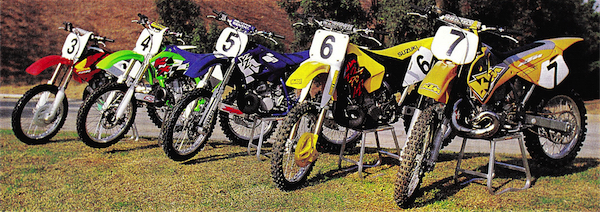 |
|
What has one case-reed, two perimeter frames (one steel and one alloy), two conventional forks, a seat made of solid concrete and more hype than a Star Wars sequel? Answer: the 250 class of 1997. |
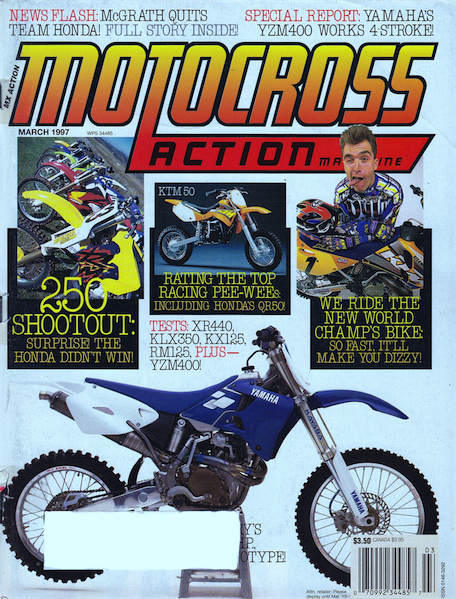 |
|
After penning some of the most colorful and entertaining shootouts of the eighties and early nineties, MXA took a turn for the boring in the late nineties. In a disappointing move, bar graphs and bland “report cards” replaced the biting prose that had been their hallmark for over two decades. |
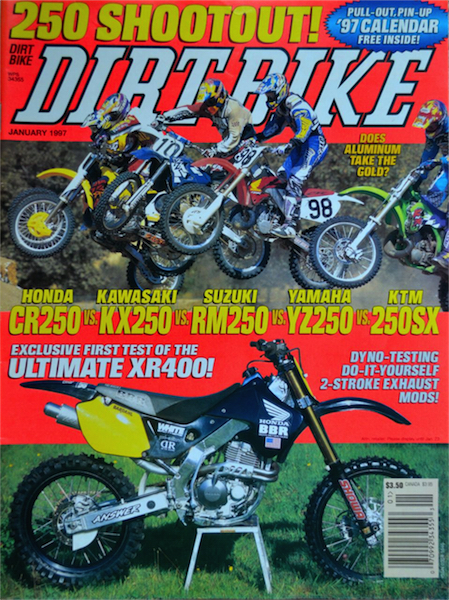 |
|
History has been less than kind to the 1997 Honda CR250R, but Dirt Bike actually loved it in ’97. At the time, they gushed “the twin-spar frame probably is the greatest thing since the invention of gasoline.”
Was this a case of hype-induced hysteria, or did too much time in the desert fry their brains? Either way, the Honda got its best ratings from Ron Lawson and the apparently two-stroke smoke intoxicated Dirt Bike crew. |
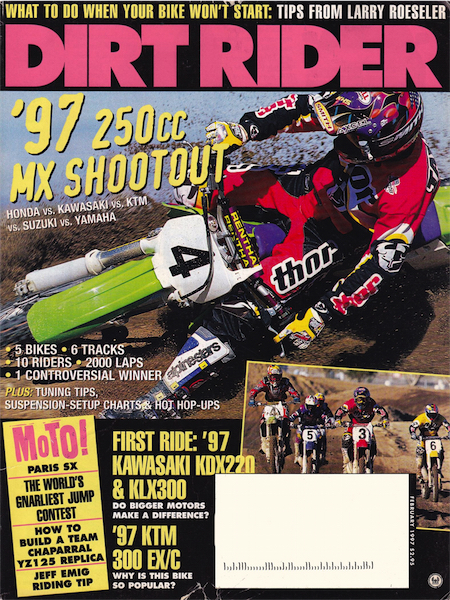 |
|
Today, the 1997 CR is remembered as a bit of a failure in design (the bike that drove away McGrath!), but it is interesting to look back and see that none of the magazines placed it worse than second in the final standings. |
 |
|
1997 Kawasaki KX250 Shootout Ranking – MXA:1st Dirt Bike: 2nd Dirt Rider:1st |
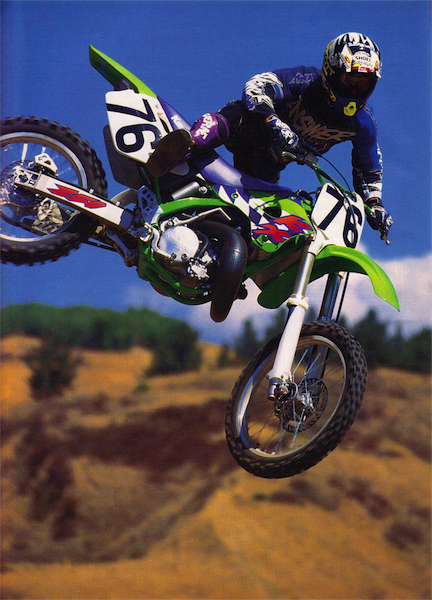 |
|
Overview: In the mid-nineties, Kawasaki was the King of burly mid-range power. Nothing snapped to attention and barked like the KX250. While it lacked the endless top-end pull of the CR, it made up for it with Open class torque and a “right-now” delivery. For ’97, Kawasaki squeezed a bit more rev out of their mid-range rocket, tweaked the handling and snatched the title of top 250 away from the rest of the field. Even Dirt Bike, who picked the spacy Honda as best by a hair, proclaimed the KX a winning machine. Its only real flaw was an overly soft fork that required a spring swap to balance out the chassis. |
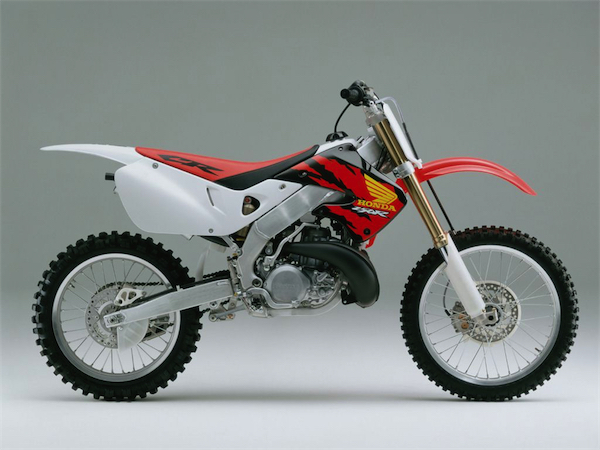 |
|
1997 Honda CR250R Shootout Ranking – MXA:2nd Dirt Bike:1st Dirt Rider:2nd |
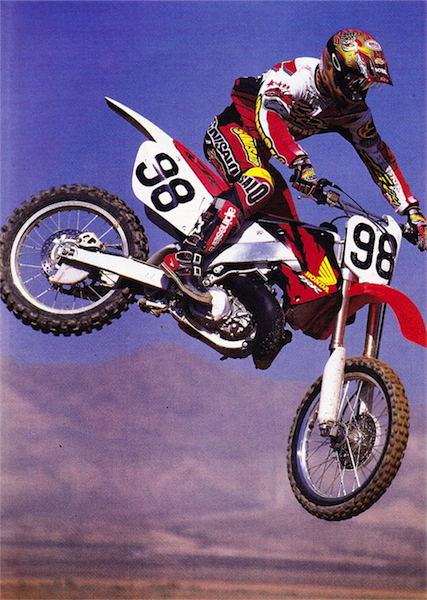 |
|
Overview: In 1997, the new CR250R was the most anticipated machine in motocross. With its fancy road-race inspired twin-spar alloy frame and swoopy looks, the CR appeared to be something from ten years into the future. In the performance department, a new “powerjet” carb, traction control ignition and 47mm “twin-chamber” fork all pointed to cutting edge performance. This CR was a bike for the new millennium and on the bleeding edge of performance.
Unfortunately, the bleeding edge often cuts both ways and the Honda may have overstepped that line a bit in ’97. With so much anticipation and hysteria built up over the bike, it seems that most of the magazines did not wish to be too hard on the machine at the time. Instead of calling its overbuilt and numb chassis a mistake, they labeled it “pro oriented” and said things like “the harder you ride it, the better it gets.” This of course, would prove to be load of spin (BS), as riders would spend the next three years trying to figure out how to get the Honda to handle worth a damn.
Suspension performance was improved in the front (but still not very good) and poor in the back, with a dead feel exacerbated by the lead pipe chassis. By far the best trait of the bike was its motor, which continued to be the star of the pin-it-to-the-stops crowd. Low-end power was mediocre, but the midrange and top end were excellent. Overall, it was a bike everybody wanted to love, but only Dirt Bike could bring themselves to proclaim it champ. |
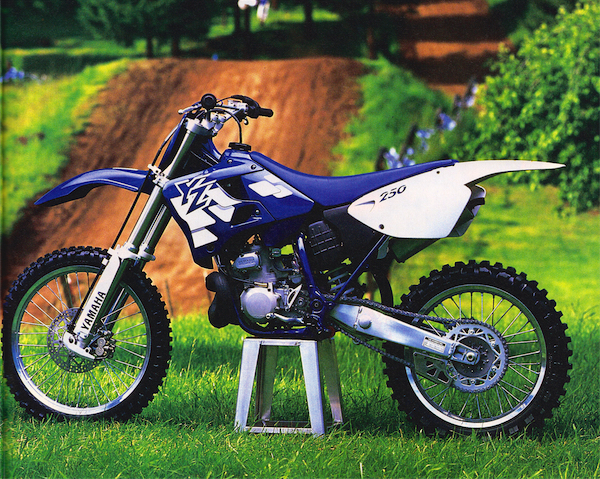 |
|
1997 Yamaha YZ250 Shootout Standings – MXA:4th Dirt Bike:5th Dirt Rider:3rd |
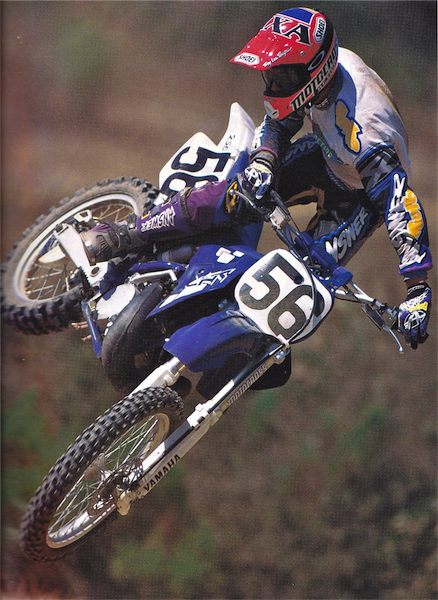 |
|
Overview: Today, most people think of the YZ250’s of this era as the best bikes available. Years of McGrath dominance have a way of doing that to people’s perceptions. In actuality, however, this generation of YZ250’s were anything but a world beaters early on. All-new in 1996, the 250 Yammer handled well and looked great, but lacked the horsepower to run at the front.
For 1997, it was more of the same as the Yamaha continued to be the slowest bike in the class by a wide margin. Mellow and lethargic were the best ways to describe its sleepy powerband. Handling and suspension continued to be excellent, but its lack of ponies relegated it to also ran status in 1997. |
 |
|
1997 Suzuki RM250 Shootout Rankings: MXA:5th Dirt Bike:3rd Dirt Rider:4th |
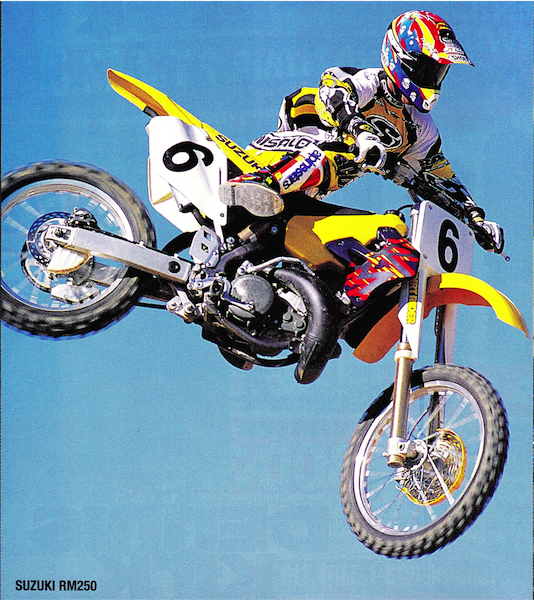 |
|
Overview: In 1996, the all-new Suzuki won the majority of 250 shootouts on the strength of its excellent suspension, sharp handling and broad powerband. It was not as fast as the CR, but much better suspended and fun to ride.
For 1997, the RM took a major step backward with a return to their midrange-only roots. 1996’s wide and easy-to-use powerband was shelved in favor of a punchy midrange blast that was heavy on hit, but light on duration. In addition to the disappointing motor, the RM’s shock took a turn for the worse in 1997 with a choppy and unforgiving ride that no one loved.
The beefy conventional Showa forks continued to be the best in the class, but that was not enough to salvage a disappointing sophomore outing. |
 |
|
1997 KTM 250 SX Shootout Rankings – MXA:3rd Dirt Bike:4th Dirt Rider:5th |
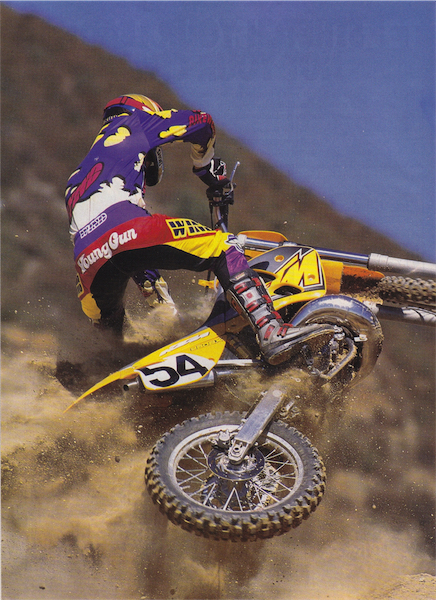 |
|
Overview: In 1997, KTM was still a bit of an acquired taste to most American racers. Its handling was out of sync with our tight and jump heavy tracks and skewed more towards the fast and flowing circuits of Europe. The suspension performance of its massive 50mm Marzocchi conventional forks and premium Öhlins shock were super-plush, but too soft for any serious motocross use. Top-end power was strong from its case-reed mill, but its enduro-like low-end delivery and notchy gearbox were panned by most testers. Braking performance and seat comfort were last in the field, with mediocre power and seat foam apparently carved out of solid oak.
While styling has no bearing on performance, it is worth noting that no one much cared for the KTM’s color choice in ’97. Kind testers referred to the KTM’s pallet as butterscotch, while the less enthusiastic editors at Dirt Rider referred to it as “baby-food orange”. At least the graphics were new and no longer a re-tread from 1995. |





